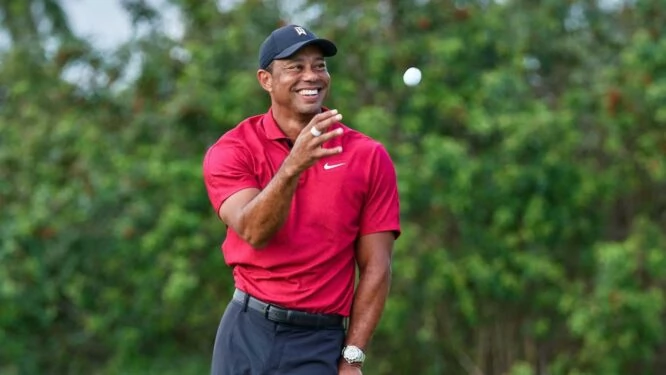The caddie and the clothes will not be the only novelty that Tiger Woods presents this Thursday when the first day of the Genesis Invitational kicks off. They are not even the most relevant novelties. The real revolution of his return to official competition since the Masters of Augusta has to do with the material and, more specifically, with the ball. Woods himself has defined it as the most important modification he has made in terms of equipment in his career.
What is the change? Tiger will continue playing the Bridgestone brand, but the model of the ball will be completely different. Until now, the multiple Grand Slam champion played the ball with the most spin on the market, the one that provided the most effect. He always said: “I will take care of reducing or minimizing that spin“. However, from Thursday he is going to play a ball with little spin.
Why has he made this change? It’s simple. Basically, the old Tiger, the usual one, the great dominator of world golf when healthy, always sought the maximum height in his shots. However, the new Tiger, physically battered, prefers to sacrifice that height for distance. His new ball does not have so much effect, therefore it does not reach so much height, it comes out faster from the club, and it makes more meters. “We gain between eight and ten yards with the new ball,” he explained. Tiger was never concerned about distance in his career because he was always one of the longest in the world. Now, between operations and age, he does need that extra that allows him to be more competitive.
What does that change produce in his shots? Fundamentally, his ball comes out of the club with a slightly lower trajectory. In any case, Woods has said that since it also comes out faster from the club, from his point of view, there is not so much change in terms of sensations. To put it in some way, he almost observes the same flight.
How has he made the ball change? It has been hours and hours of work on the practice court with Bridgestone engineers. “The first task was to hit many balls on the court until I found the one that I really felt comfortable with. There we used the Full Swing Monitor (a swing analysis computer) to know the distances, ball height, attack angle, that is, to have all the numbers. The next step, once we decided that we had the ball we wanted, was to test it in competition conditions. It is about recreating the most faithful possible situation that I am going to find in a tournament, trying to reach the same level of pressure. For this, I go out to play with several PGA Tour players in the area and we compete as if it were a tournament, a real stress test. When I check that the ball behaves as I want it to in a stable way under these conditions, that’s when the process is closed. It’s the ball. As for the short game, technology does not influence anything there, I just listen to my feelings”, he told Golf Digest.
Advice for amateurs: “The best players in the world have solid routines before shots, as it is almost impossible to compete under pressure without them. Amateurs almost never have a good routine before the shot. If they use it consistently eliminating thoughts and distractions and letting the golfer inside them make the swing, it will be good. Amateurs tend to believe they are better than they are, they think they have more club speed than they really have and they assume they hit longer than is realistic. With clubs, they use too small a loft, too stiff shafts and less tolerant than they need. As for the golf ball, they do not take fitting seriously and often limit themselves to choosing the model that their favourite player uses. They would be better off with a more forgiving golf ball, with a softer compression and that adapts to their swing speed. Tolerance for error in golf is your friend, use it to your advantage”.




